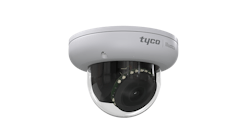Airport security camera technology is one of the most critical systems that contributes to a safe environment for the traveling public. As an indispensable part of airport security and operations infrastructure trends and upgrades, Burns is continually engaged in healthy discussion on the subject. Clients commonly ask questions about positioning, fields of view and general aesthetics, but recently, questions have centered around investigation into alternative cameras. Owners want to know – what can they do differently?
Like most technology-based equipment, security camera technology continues to evolve and offer better overall visual surveillance options. Related processing, network, and storage solutions progress in parallel, and have made significant impacts on the daily function, operation and maintenance of visual surveillance systems. There are some significant changes that relate to the unique requirements of security video systems that are in, general terms, providing security users clearer images across broader environments.
Aviation market heats up
The trends we are seeing related to camera technology have been picking up in the last year in the aviation market and are likely to continue, if not increase, over the next few years. And, while there are some interesting security-specific developments (see below), a common trend has to do with advanced security video camera technology tied to personal use consumer technology – this reason is simply based on sheer volume.
According to Strategy Analytics, smartphone sales for Samsung came in at $291.3 million and for Apple, $206.3 million. It’s no secret that security camera technology is greatly influenced by smartphone video camera trends. As a result, consumer camera trends will likely continue to provide a direct and significant boost to the quality and functionality of airport security technology.
The three basic video camera variables – lens, iris, and focus – are evolving to provide sharper focus, increased depth of field, wider speed range, and greater dynamic range. While overlap exists and some of these are inter-related, the broad advances moving from evolution to more revolutionary are sensor technology, sensor quantity, and image processing.
Sensor Technology Improves and Identifies Security Targets
The most direct evolution of security camera technology has to do with sensor technology. Single frame and video camera sensors have grown in resolution, driven largely by the miniaturization of light capturing sensors. As the sensor sizes decreased (2/3”, ½”, 1/3”), it became practical to first provide the same resolution in a smaller package, followed by an increased resolution in a similar form factor. Sensors have evolved from HD 720, FHD 1080, and now 4K resolution in the mini-dome package, commonly used for security applications.
Along with increased image resolution, the sensors have become more sensitive to light, allowing them to reduce aperture, increase depth of field and provide greater scene focus. This evolving sensor technology provides a more detailed image to benefit the detection, recognition, and identification of security targets.
Sensor Quantity Increases Coverage
Over the last five years, even more revolutionary than the actual sensor technology is the increased use of multi-sensor cameras. While advances have been made to increase field of view coverage with wider lenses focusing on high-resolution sensors, another approach developed to use more than one sensor in the camera housing. These types of cameras are a byproduct of the increased processing power available at the camera, which followed Moore’s Law – the observation made by Intel co-founder, Gordon Moore, that the number of transistors on a chip doubles every two years while the costs are halved. Moore’s law suggests exponential growth.
Airports have been increasingly interested in these multi-sensor cameras. Not only do they benefit from this evolving sensor technology, but they also provide increased coverage versus a single camera.
Multi-sensor cameras borrow from the consumer market, where dual and multi-camera cell phones are becoming a standard affair. Security cameras with more than one sensor provide a new way to meet airport security challenges through increased field of view, higher detail, and additional view range. This increased security is now achieved using the same infrastructure and similar equipment footprint – often at a premium in the airport environment.
Panoramic Camera Provides Easier Tracking
The panoramic camera, offered by most security manufacturers, initially required special viewing software to stitch a scene together from its sensors. That’s changed. Now, many cameras now do this at the camera and provide a single stream output. The advantage of the panoramic camera is to provide a wide and continuous field of view. This allows security to more easily track a target in lieu of overlapping traditional cameras. And, some unique alternatives to this may also include a pan, tilt, zoom (PTZ) integrated in the same housing to allow interrogation of a scene from the same view angle as an original fixed panoramic scene.
High Depth of Field (DOF) for Large Spaces
Using sensors on a large, but more traditional field of view camera is also an option. While these cameras require more intense processing at the camera to present a continuous scene, they offer some interesting advantages related to varying the three basic camera elements of lens, iris and focus to parts of the scene. It’s still unclear if these security-specific cameras will see widespread industry growth or adoption.
The high DOF camera is ideal for large spaces and movement over large areas. A technical limitation is that the focus distance steps up over distance as the lens package overlaps. However, the overall focus should still be appreciably better than a standard single high-resolution sensor.
The downside to high DOF cameras is that their limited application may make the technology unsustainable for long-term adoption in the industry. For example, the Lytro L16 garnered significant attention when it was announced as a multisensory camera for the consumer market, but the hype was too far ahead of the software and the company’s product development seems to have waned.
Image Processing Poised for Growth
A quickly emerging area that stems from the consumer side but has yet to gain significant traction in the security market is related to software and image processing. The largest growth in this area will first happen on the consumer side, followed by impacts to the aviation security market. With quick and widespread adoption in the significantly large consumer smartphone market, it would not be surprising for these to change the security camera market quickly.
Software defined: Focus, DOF, High Dynamic Range (HDR)
Most of the large cellular phone companies have been developing software to enhance and increase the quality of video from their lens and sensor package. This trend will certainly continue and carry over into and impact the aviation security market. It will be interesting to see how this evolves – like the deployment of security analytics – over the next few years, and how the debate between camera (edge) and headend processed analytics develops.
In addition to software-refining video, there is also early military and scientific research on this front related to various non-optical, lens-less or related wave-front sensors for software defined radios. The consumer side of technology, again, through economies of scale, is already deploying software-defined HDR, DOF, and other focus methods for smartphones including OS-managed or SDKs for computational photography.
Eliminating Lenses
Even further down the line are early advancements in technologies to eliminate optical lenses all together by processing raw sensor data. The early material from this type of technology is limited, but includes university-based research (Caltech, Cornell, and Rice) and the imaging company Hitachi.
So, as airports around the world increasingly realize the benefits of new camera technology to enhance security operations and situational awareness, it’s likely they will begin to use more advanced surveillance systems to cover more area to keep passengers safe and operations running smoothly.
Matthew Meier, PE, CTS-D has over 17 years of experience in airport design and management, leading numerous large-scale security, IT, and communications infrastructure projects. His leadership has served many domestic and international airports, including Orlando International Airport, Nashville International Airport, Dallas Ft. Worth International Airport, and King Abdulaziz (Jeddah KSA) International Airport. Matthew is Principal Systems Engineer at Burns Engineering.





![Philadelphia International Airport [PHL] is working with Arora Engineers to upgrade their surveillance system in areas in Terminals A – West and A – East. Philadelphia International Airport [PHL] is working with Arora Engineers to upgrade their surveillance system in areas in Terminals A – West and A – East.](https://img.aviationpros.com/files/base/cygnus/cavc/image/2022/09/cam.6321eaa49a1c5.png?auto=format,compress&fit=&q=45&h=139&height=139&w=250&width=250)
